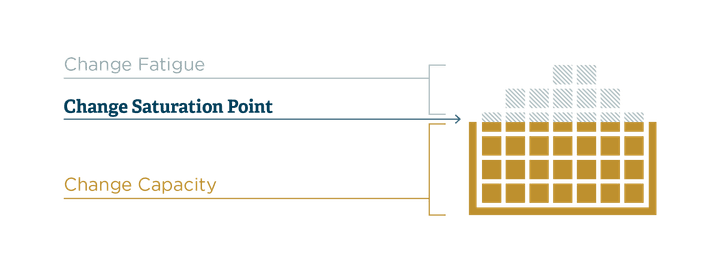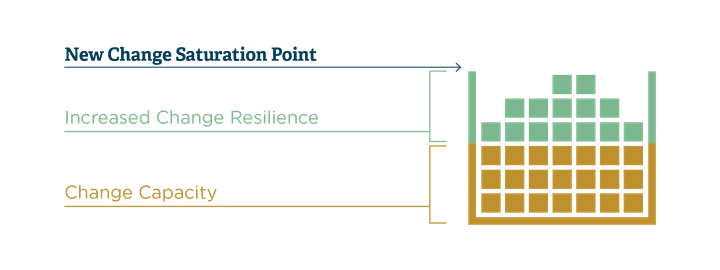Looking back to the past five years, how many significant changes have you had to navigate in your workplace? Beyond the upheaval the pandemic caused, we’ve gone through the Great Resignation, Quiet Quitting, the reversal of remote work with back-to-office mandates, organizational realignments and restructuring, digital transformation acceleration, AI and automation implementation, and efforts to improve efficiency and operations, and not to mention, the rollercoaster economy of late. Collectively, I think we’re all a little worn out. It’s no wonder we’re now entering “The Great Exhaustion.”
Organizations have experienced on average 5.1 significant change events over the past 12 months. – 2024 Propeller People & Change Insights Report
The fact is that organizations are navigating continuous transformations to stay competitive. The pace of change is not going to slow down; if anything, it is likely to keep increasing. So, our task as leaders and change managers is to not only help people adopt new changes but increase their ability to adapt. And data has a role in that journey.
In this blog, we’ll show you how to leverage your people data to manage change capacity and build resilience within your organization.
Related Content: Expert Insights on Creating Organizational Efficiency
# Setting the Stage: Change Management Fundamentals
Before we discuss how you can use your people data, let’s review some key change management terminology (or skip ahead if you’re already a pro!). Understanding these terms is crucial as they will be inputs into our Change Portfolio Tool. By defining these terms, we lay the foundation for a shared understanding.
Change Impact
Change impact refers to the effect and consequences of a change initiative on an organization and its processes, people, and goals. This includes both intended and unintended outcomes.
- Importance: Understanding the impacts of change is crucial to managing it effectively. It helps in planning and mitigating negative effects on employees and operations.
Change Capacity
Change capacity is the ability of an organization or group to absorb changes, considering individual, group, team, and organization-wide capacity.
- Importance: Assessing change capacity ensures that organizations do not exceed their limits, helping prevent employee burnout and maintaining productivity.
Change Saturation
Change saturation is the point at which an organization or team experiences an overload of change initiatives or activities, potentially leading to reduced effectiveness, burnout, or resistance.
- Importance: Recognizing change saturation helps organizations take proactive steps to manage workloads and prevent resistance.
Change Fatigue
Change fatigue is weariness and reduced enthusiasm caused by continuous or frequent changes, which often leads to decreased engagement and performance.
- Importance: Combatting change fatigue is essential to maintain employee engagement and performance, ensuring the success of change initiatives. Change fatigue can not only have a negative impact on individuals but also impact business performance adversely.
Change Resilience
Change resilience is the capacity to withstand and adapt to various changes and disruptions effectively.
- Importance: Building change resilience ensures that organizations and employees can adapt to changes effectively, maintaining productivity and morale.
The end goal of any change initiative and change management effort is to avoid change fatigue and build a resilient culture of change. So, how do you help your people be resilient?
# Navigating the Path: From Burnout to Resilience
To help connect these terms, visualize change capacity as a bucket and change impacts as water filling that bucket. Each person, team, and organization has a specific capacity for change. As the bucket fills up with individual change impacts, the remaining capacity is reduced. When the bucket overflows, that’s the team’s change saturation tipping point. Any additional changes will create change fatigue.

As you build change resilience — you’re increasing the size of the bucket. With a larger “bucket,” your team will be able to handle more change impacts without exceeding their change saturation point.

Leaders need to enable team resilience, not burnout. Your data can help provide measurements and decision-making frameworks to manage continuous change.
# A Data-Driven Approach to Change Decision Making
What often happens instead of data-driven decisions around change is the “feeling” that change can be too much for a team to handle as the cracks start to show – which is often too late to avoid the burnout path. Data can be the tool to predict these risks and facilitate informed conversation about how and where to mitigate fatigue.
The good news? The data you need to drive these conversations is likely already at your fingertips – you just need to pull it together into a comprehensive picture.
# Key Data Inputs for Managing Change
To have a full picture of change implications, you’ll want to gather different data sources. This doesn’t need to be a big lift – but it will require partnerships with HR, project offices and key impacted teams. Here are the key data sources to consider:
- People Analytics: People analytics involves collecting data on employee engagement, skills, and well-being and using that to understand workforce performance and engagement. For instance, tracking employee surveys, turnover rates, and skill development progress can provide insights into the organization's human capacity to adapt to change. If the data shows that employees are highly engaged and developing relevant skills, it indicates a strong change capacity and resilience.
- Project or Initiative Portfolio: Project and initiative portfolio information includes data on the number, scope, and progress of ongoing projects. If an organization has too many concurrent projects with overlapping objectives, it may indicate a saturation of change initiatives. By analyzing the data on these projects, leaders can identify potential bottlenecks and streamline their portfolio for better change management.
- Change Analytics: Change analytics involves tracking the success and impact of previous change initiatives. For instance, data on the adoption rate of new technologies, the time it takes for employees to adapt, and feedback on the change process can reveal the effectiveness of past changes. If these metrics show high levels of resistance and extended adaptation periods, it may signal a risk of change fatigue.
- Operational Analytics: Operational analytics encompasses data on an organization's efficiency and effectiveness. For instance, analyzing data on production efficiency, supply chain performance, and customer satisfaction can provide insights into how well the organization can handle change. If operational analytics data shows that the organization consistently meets targets during periods of change, it signifies a healthy change capacity.


# Building a Change Portfolio
Let’s move beyond theories and definitions and discuss how you can use data sources to manage capacity and avoid fatigue. We will walk through a step-by-step example of how to compile the various data inputs we’ve discussed and transform them into a functional Change Saturation Portfolio.
Before we get into the weeds, though, there are two key “must-dos” when building this portfolio:
- Look at change as a portfolio – not as individual changes.
Due to the nature of change in this era, individual changes are never felt in a vacuum. You must view individual changes as part of the bigger picture which includes everything a team or organization is experiencing at that moment. - Look at change at the team level.
Each team has its own capacity and appetite for change and will experience a different set of change impacts. While this portfolio can be beneficial at the organizational level, the ability to mitigate risks to the business needs to happen with a more team-based lens.
# A Step-By-Step Guide
Download our Change Portfolio Tool and follow the steps below to use it.
Start Here: Look at Operational Metrics for a Baseline
You begin by examining the operational metrics of a specific team. Although these metrics may not directly contribute to the overall picture of change, they provide a benchmark for normal performance. When a team experiences change fatigue, it can have significant negative impacts on operational metrics, making them essential for evaluating and discussing risk with the team’s leaders. Effective change strategies and approaches should be built on this foundation — what level of team performance do we need to uphold during these changes?
- Gauge Capacity Through People Analytics: Use people analytics to assess the current capacity of your workforce. Even if you don’t have a People Analytics team, you’re likely already collecting much of the data you need. This will provide a view of each team’s existing resilience and engagement. Our tool suggests some starting place for these metrics, such as employee engagement as the primary driver, turnover rate, and skills development and mobility. However, these can be adapted for the key drivers of engagement and change agility that you have available. You will rank these measures on a scale to get to a team’s relative change capacity.
- Assess Individual Initiative Impact: Evaluate the impact of each change initiative on this team by partnering with PMOs and operations leaders to understand project timelines. Take any detailed change impact assessments you have and roll them up into a high-level impact rating on how much this change will impact the core operations of the team. Consider the timeline for when this team will be aware and distracted by the change - typically from initial training through full stabilization. This builds a timeline view of impacts on the team, combining your Project Portfolio and Change Analytics data and providing a broader view of all the changes this team will face throughout the year.
- View Timeline Impact Per Initiative: If you’re using our tool, it will start to do work for you. The above impacts will show up in a single visual view to analyze the timelines of the various initiatives and allow the team to understand their overlap and cumulative impact. The heat map can be a very helpful tool to visualize high periods of change. If you’re creating this yourself, the important thing is to create a view that shows how changes overlap and build on one another — knowing that cumulative change can be felt more strongly than any individual transformation.
- Look At Impact Against Capacity: Compare the impact of change initiatives against the available capacity (from step 1) to identify potential overloads. This will help you visualize potential moments of change saturation. It can also help crystalize the differences in change capacity from team to team. For example, a start-up tech team might have a high degree of change ability and can absorb many parallel changes, while a tenured and less engaged finance team may only be able to absorb one significant change at a time.
- Assess Risk: With a timeline view of Saturation against Capacity, assess the operational risks. Revisit your original metrics and evaluate the amount of change the team is absorbing and the risk to the business. How much risk are you willing to absorb? How much impact to the business will the changes have when they compound? By assessing your risk, you can then identify the appropriate mitigation tactics for your team and the current moment.
# Strategies for Mitigating Change Fatigue
Once you have identified saturation, you need to decide what levers exist to mitigate. In partnership with an executive or portfolio team, you can use this framework to assess options. These options are not mutually exclusive; you can and should use multiple levers when mitigating risk.
- Accept Operational Dips — Referencing the original operational KPIs, align as a team to accept the impacts and expect performance to dip during that time. This is the easiest (and least effective) lever.
- Increase Change Support — Increase the team's change support, ensuring you have additional change managers, trainers, champions, SMEs, and leadership support to make the individual impacts less painful. This helps ease the burden of the cumulative change.
- Adjust Timelines—Go back to your portfolio analytics and see where there might be flexibility. Can you postpone an initiative until later in the year to avoid compounding change? Work with leadership to deprioritize or shift timelines for secondary and tertiary priorities.
- Bolster Operational Capacity—Hire additional support ahead of high change periods to ensure operational metrics are met, and the team has more capacity to learn and absorb the new changes.
- Grow Resilience and Change Capacity—The long-term goal is to grow change resilience. Returning to your people analytics: what are the levers outside of the change portfolio that can increase engagement, learning, and so on? A component of this is avoiding change fatigue and then pairing that with employee engagement, mentorship, growth, and investment tactics that increase the stickiness of the employee relationship.
# Transforming Change Saturation into Resilience
Managing change fatigue is crucial for maintaining employee engagement and organizational effectiveness. By leveraging data-driven strategies, organizations can better manage change capacity and build resilience. Assess your organization’s change capacity today and start implementing data-driven approaches to build resilience.
Need support on this journey? Our People & Change experts can help you navigate the complexities of organizational change, ensuring your teams remain engaged, resilient, and effective. Whether you need support with change management, employee engagement, or building organizational resilience, our experts are here to guide you every step of the way and help your organization thrive in times of change.





